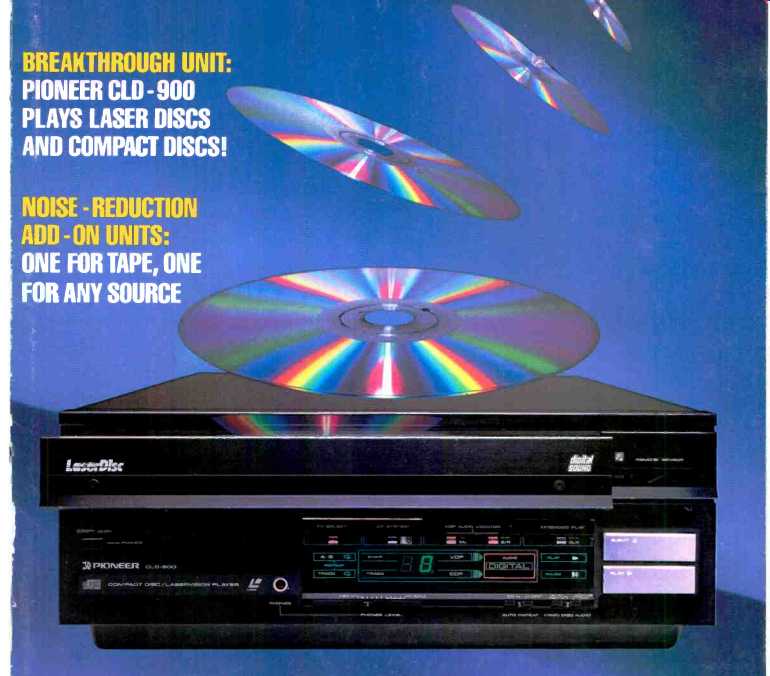
Manufacturer's Specifications:
CD Player Section Only:
Frequency Response: 5 Hz to 20 kHz, ±0.5 dB.
S/N Ratio: 96 dB.
Dynamic Range: 96 dB.
Channel Separation: 94 dB.
THD: 0.003% at 1 kHz.
Output Level: 2.6 V at 0-dB level.
Power Consumption: 42 watts.
Dimensions: 16 1/2 in. (42 cm) W x 6 3/8 in. (16.8 cm) H x 17-9/16 in. (44.7 cm) D.
Weight: 35 lbs., 3 oz. (16 kg).
Price: Approximately $1,200.
Company Address: Pioneer Video, 200 West Grand Ave., Montvale, N.J. 07645.
It was bound to happen sooner or later. Nearly two years ago, I was speaking to Bart Locanthi, a leading technical executive with Pioneer on the West Coast. Even then, he hinted that the presence of a common element-the laser pickup-in CD players and LaserVision videodisc players suggested that a player could be built to handle both types of program sources. At the recent Japan Audio Fair, held in Tokyo in the fall of 1984, Pioneer demonstrated the first such combination player. A month or so later, I was given a production prototype of the machine as it will be marketed in the United States early this year.
What Mr. Locanthi failed to tell me during our discussion was that it is possible to record the soundtracks on a LaserVision videodisc using the digital-audio CD format, and that such discs would become available when the combination player became a reality. Indeed, that is just what has happened. With this first combination CD/LV player I was given a videodisc which contains not only the AFM (audio frequency modulation) audio tracks which have been the standard all along (it is similar to the AFM technique used in Beta Hi-Fi and VHS Hi-Fi, and is therefore of excellent quality), but also contains CD audio, totally digital.
Incorporating both kinds of audio is, of course, essential for compatibility, but on a player such as the new Pioneer CLD900, the sound reproduction can be of the quality and dynamic range of CDs.
Pioneer has taken advantage of the more obvious similarities between videodisc and Compact Disc players, but they have gone beyond that. I was as impressed by the clever way in which they have assigned dual functions to the buttons on the supplied wireless remote-control unit as I was by the design of the actual player itself. The designers of this incredible instrument assumed (rightly, I believe) that when playing a Compact Disc you would still have the video output of the unit connected to your TV set or video monitor.
This being the case, they arranged for that video screen to display all the information sometimes found on CD players.
Therefore, the front panel of the CLD-900 remains relatively uncluttered, considering the great number of operational modes it supports.
As for the LaserVision features, they are just about the same as those found in Pioneer's dedicated videodisc players, such as their Model LD-700. The same wireless remote used when playing Compact Discs also controls such video special effects as freeze-frame, single-frame advance, slow motion, fast motion, and random access to individual frames by number. These effects, however, are available only with CAV (Constant Angular Velocity) discs, which play for 30 minutes per side, not with the more common, hour-per-side CLV (Constant Linear Velocity) discs. Like the LD-700, the CLD-900 is front-loading and handles either 12-inch or the newer 8-inch discs in CAV or CLV formats. Molded ridges inside the loading drawer help you to properly position both sizes of LaserVision discs as well as the 12-cm (4.7-inch)
CDs before you push the drawer closed and begin play.
Control Layout
Most of the upper front panel is taken up by the disc loading drawer, which is opened by pressing the "Eject" button near the right edge of the panel or on the battery operated, infrared remote control. Below the drawer, at the left, are a power on/off button and a stereo headphone jack.
The TV video selector button is located near the center of the panel, next to the CX noise-reduction on/off switch. This form of dynamic noise-reduction circuitry, found on earlier LaserVision players, is used only when playing CX-encoded discs. The switch won't do anything if you play a future LaserVision disc with CD digital audio tracks, since no noise reduction would be needed with these already noise free discs. Whether you are playing CDs or LV discs, a multi-function display lets you know what's happening: Numerals tell what CD track you're hearing or which LV "chapter" you are watching. Illuminated words tell you whether you are in the "Pause" or "Play" mode, whether soundtracks are digital or analog, whether you have selected one of the repeat-play features (and, if so, which one), and whether audio is left-channel, right-channel or stereo. Additional small indicator lights tell the viewer whether the CX noise reduction mode has been selected and whether or not an extended-play (CLV) videodisc is being viewed.
The more sophisticated special-effects and programming features available on the CLD-900 are accessible only via the hand-held remote control. It is this little module which lets you quickly access a specifically numbered "frame" on a videodisc (as many as 54,000 frames can fit on one side of a standard-play LV disc), choose one of several slow-motion or fast-motion viewing speeds, go into freeze-frame or frame-by-frame viewing, access a given chapter of an LV disc, quickly scan forward or backward to find the scene you want to watch, or turn on displays (superimposed on the picture you are watching) that show the chapter as well as the frame being viewed. When playing a CD (audio-only) disc, most of the touch buttons used for videodisc special effects and programming serve similar functions. You can access tracks or index points (if the latter are encoded .on the disc you are playing). You can fast-scan the music (the music remains audible and does not change pitch while you scan), and of course, you can turn on the additional displays, visible on your video screen, that tell you the time into the track you are playing, the remaining time of the entire disc, and even the total time of the disc. Repeat-play, either from one point to another or for an entire track or disc, is possible both for LaserVision and Compact Discs.
Measurements
For the purpose of this report, I concentrated primarily on the CLD-900's audio performance as a CD player. I was unable to measure its audio performance with either the analog or digital soundtracks of LaserVision discs, as I was unable to obtain a suitable test disc.
As to the video performance, let me simply reiterate something that's been said by many others, many times: The LaserVision videodisc format gives you the very best picture presently available on a home video screen. Picture resolution surpasses what you can get with the best models of videocassette recorders, even at their fastest tape speeds. I would hope, personally, that now that the LaserVision's video virtues can be combined with the benefits and fidelity of Compact Discs, perhaps more people will come to recognize just how great the combination of crisp video pictures on a good TV monitor plus digitally recorded and reproduced stereo audio can be.
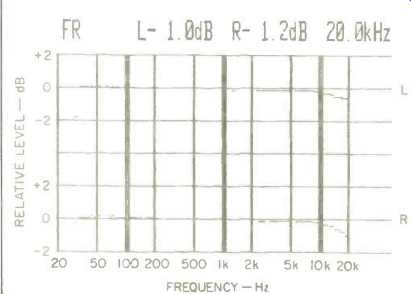
Fig. 1--Frequency response, left (top) and right channels, at 0-dB level.
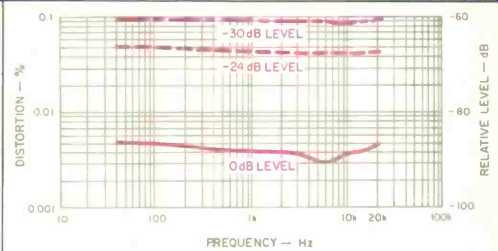
Fig. 2-THD vs. frequency at three signal levels.
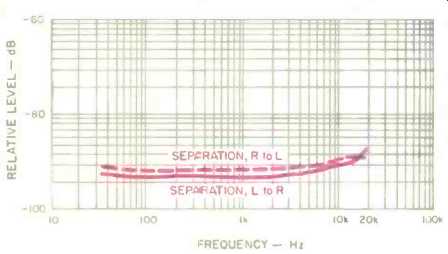
Fig. 3-Separation vs. frequency.
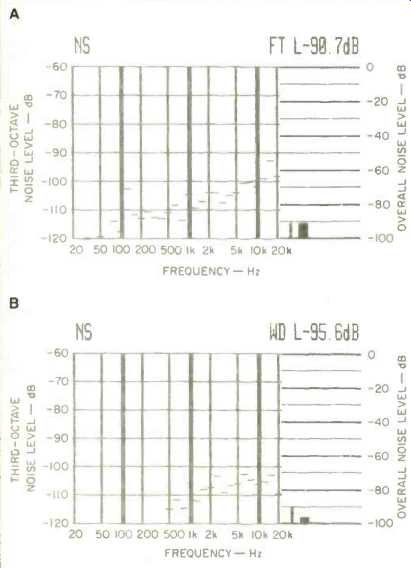
Fig. 4--S/N analysis, both unweighted (A) and A-weighted (B).

Fig. 5--IHF twin-tone IM test (14 and 15 kHz) showed 0.03% distortion-more
than usual, but still minute.
Having said that, let me go on to the CD player measurement results. Figure 1 shows the playback frequency response for the left and right channels. The vertical scale is 2 dB per division so as to highlight any small deviations from ruler-flat response. There were none to speak of, and, with the cursor of the graph set to read relative output at 20 kHz, the readings were only off by 1.0 and 1.2 dB for the left and right channels respectively.
Harmonic distortion at mid-frequencies, for maximum recorded level, measured 0.004%, remaining essentially at that low level over the entire audio spectrum. There was no evidence of any super-audible "beats" such as those I have found with so many other CD players. In fact, for a 20-kHz test tone, the single THD reading (which normally rises as a result of non-harmonically related beats) remained a low 0.0045% at 0-dB (maximum) signal level. Figure 2 shows distortion versus frequency for maximum recorded level (0 dB) as well as for levels of-24 and-30 dB. As usual, the THD increases at lower output levels: At the-30 dB recorded level, THD for a 1-kHz signal measured 0.09%. Output linearity was accurate to within 0.3 dB down to 80 dB below maximum recorded level. Stereo separation or crosstalk is shown in Fig. 3 and was extremely uniform over the entire range of test frequencies used. As with many other CD players, there was only a minimal decrease in separation at the frequency extremes. This suggests that the analog output stages of the player have been designed with good isolation between left and right channels.
Signal-to-noise ratio, measured without any weighting network, was 90.7 dB, increasing to an even higher 95.6 dB when an A-weighting network was introduced in the measurement path. An analysis of the noise content as a function of frequency distribution is shown in Figs. 4A and 4B. The SMPTE-IM distortion was a low 0.004% at maximum recorded level, increasing to 0.012% at-20 dB recorded level. The CCIF (twin-tone) IM, using signals at 19 and 20 kHz, measured only 0.002% at the equivalent of maximum recorded level and 0.0028% at-10 dB. I thought it more significant that I detected a small amount of IHF-IM distortion. At 0.03%, it was still minute, but on most CD players, IM is too low for my equipment even to measure. Figure 5 shows what happens when the player reproduces the IHF-IM test's twin tones. The two tall spikes represent the 14and 15-kHz test tones, while the small spike just to their left is a spurious signal, 1 kHz lower. (The sweep here is linear, at 2 kHz per division.) The amplitude of this spike is approximately 70 dB lower than the composite of the two test tones, or 0.03%. Square-wave reproduction of a 1-kHz, digitally generated square-wave signal (Fig. 6) was typical of that produced by CD players that use multi-pole, analog output filters, as was the reproduction of the unit pulse (Fig. 7). With a 200-Hz signal reproduced from the left channel and a 2-kHz signal coming from the right channel, there was little evidence of phase shift between the higher frequency and the lower one. Perfect phase relationship would be indicated by both sine waves in Fig. 8 crossing the zero axis in a positive going direction at the same time-a condition which occurs near the right side of the 'scope photo of Fig. 8.
The CLD-900 was able to "read" through all of the built-in defects in my special Philips error-correction and tracking test disc. Specifically, it ignored 900-micron linear distances of missing information as well as 800-micron diameter simulated dust particles (actually black dots embedded beneath the surface of the test disc) and semi-opaque, simulated fingerprint smudges. This unit played the various musical tracks encoded beneath the defects without any muting and without skipping of any kind.
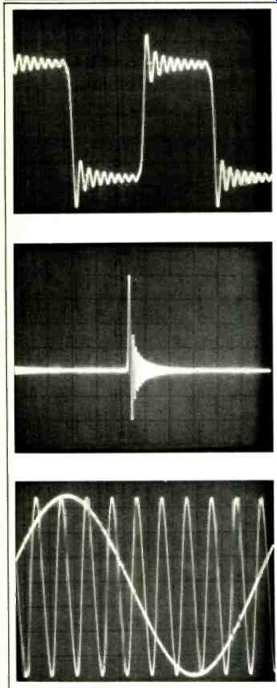
Fig. 6--Square-wave reproduction, 1 kHz.
Fig. 7--Single-pulse test.
Fig. 8--Twin-tone phase test signals (200 Hz and 2 kHz) showed negligible phase shift in CD player section.
The CLD-900 plays CDs plus 8- and 12-inch LaserVision videodiscs.
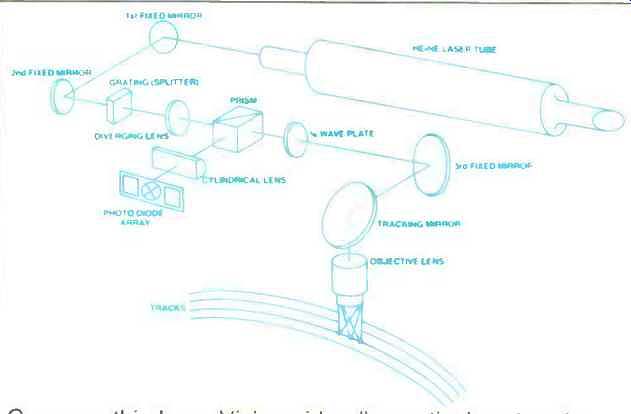
Compare this LaserVision videodisc optical system to the CD optical
system in this issue's "Digital
Domain."
Use, Listening and Viewing Tests
Besides the usual assortment of favorite CDs that I use to evaluate the sonic performance of CD players, I listened to, and watched, the single LaserVision disc I had borrowed which contained digital (CD format) audio tracks and the AFM tracks normally found on LaserVision videodiscs. Unfortunately, the musical material on this videodisc did not provide sufficient opportunity to compare the two types of soundtracks, even though a switch on the front panel of the unit does let you select "Analog Only" sound. There were few silent passages in this particular disc, so I found it difficult to judge how much quieter the background was when I switched to the digital format.
Of course, when I played my regular CDs on the player, it performed handsomely, offering just about the same high quality of sound I have been getting from most CD players I've been measuring of late, as well as very fast access to a given point in a disc when I used the remote control for programming. As far as I could tell (I had only a Japanese owner's manual), there are no programming features on this machine. That is, you can't store a set of track or index playing instructions in any sort of memory. On the other hand, you can access a given point in a disc both by track and by index points (if the disc has been encoded with them). Audible scanning is also possible, as is scanning of videodiscs at a variety of fast- and slow-motion speeds.
I found the hand-held remote control easy to use. Color coding helps you push the right buttons for the right functions. Blue buttons are exclusively used for videodisc functions, while green buttons are used exclusively in CD operations. Buttons lacking either of these colors perform equivalent functions for both program sources.
As for the displays which are visible on your TV screen while you use the player for CD reproduction, you don't have to keep your TV set on for that display. Remember, the player itself tells you the track you're playing, and that's really the most important display you need when listening to a CD. Still, I found the video display to be a delightful addition, and I must confess I couldn't help gazing at it as I listened to my CDs. No doubt I would have grown tired of this feature in time, and so, probably, will you. But you're not likely to tire of the excellent video reproduction and, now, the excellent sound quality you can get from this combination player. It's been a long time since Bart Locanthi hinted that such a unit would someday be available, but the CLD900 has been worth the long anticipation and the long wait.
-Leonard Feldman
=================
(Audio magazine, Feb. 1985)
Also see: Digital Domain -- Keeping Your Distance (Feb. 1985)
Hitachi DA-600 Compact Disc Player (Feb. 1985)
Proceed PCD CD Player and PDP D/A Converter (Apr. 1991)
= = = =